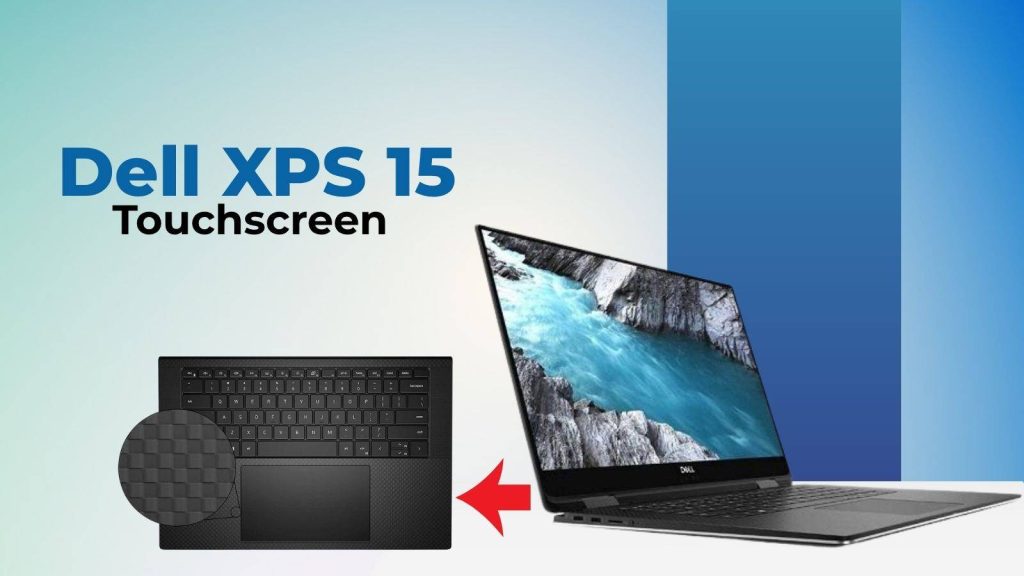The Dell XPS 15 is widely recognized for its sleek design, robust performance, and premium features, and one of its key selling points is the Dell XPS 15 touch screen. For professionals, creatives, and everyday users, the touchscreen adds convenience, interactivity, and flexibility that a traditional laptop screen cannot provide. Touchscreen durability is always a concern, especially in high-end laptops where repair costs can be significant.
Find the durability of the Dell XPS 15 touchscreen, highlight common problems and their causes, offer practical solutions, and provide tips to extend the life of this premium display.
Dell XPS 15 Touchscreen: Key Features
Dell XPS 15 touchscreen is crafted to deliver a premium user experience, combining high performance with versatile usability. Its design and technology make it suitable for professionals, creatives, and casual users alike. Below are its key features in detail:
1. Display Options
The XPS 15 features a 15.6-inch display available in Full HD+ (1920×1200) or 4K Ultra HD+ (3840×2400) resolution. The Full HD+ option balances performance and battery life, while the 4K Ultra HD+ display offers stunning clarity, making images, videos, and text extremely sharp.
Both options support wide viewing angles, ensuring consistent quality whether you’re watching movies, editing photos, or presenting slides.
2. Multi-Touch Support
Touchscreen supports 10-point multi-touch, allowing smooth gestures like pinch-to-zoom, swipes, and scrolls. This feature enhances navigation in Windows 11 and productivity apps. For creative professionals, the XPS 15 is compatible with digital styluses, enabling precise drawing, note-taking, and design work. A designer, illustrator, or architect, this multi-touch capability adds flexibility and precision to your workflow.
3. Gorilla Glass Protection
The screen is protected with Gorilla Glass 6, providing excellent resistance against scratches and minor impacts. This layer also minimizes smudges and fingerprints, keeping the display clean and maintaining image clarity over time. Users can confidently use the touchscreen daily without worrying about common wear and tear.
4. Color Accuracy and Brightness
The XPS 15 touchscreen is engineered for high brightness levels and wide color gamut coverage, supporting nearly 100% of the AdobeRGB spectrum on higher-end models. This makes it ideal for tasks that demand accurate color representation, such as photo editing, video production, and professional presentations. Users can rely on consistent, vibrant colors across different angles, which is crucial for creative work.
5. Edge-to-Edge Design
Modern infinity-edge display design not only looks elegant but also maximizes screen-to-body ratio. This means you get a larger usable display area without increasing the laptop’s overall size. It enhances immersion when watching videos or working on multiple applications, making the device feel more spacious and premium.
6. Responsiveness
The Dell XPS 15 touchscreen is highly responsive, with minimal input lag. This ensures smooth interactions whether you are navigating through apps, multitasking, or using creative tools. The quick response time makes it suitable for both productivity and entertainment, providing a seamless experience across tasks.
These features collectively make the Dell XPS 15 touchscreen one of the most advanced and versatile laptop displays available today. However, despite its premium build, users should be aware of potential issues like touch sensitivity quirks or occasional screen flickering, which can occur with any high-end touchscreen device.
Causes of Dell XPS 15 Touchscreen Issues
Understanding the reasons behind touchscreen problems helps users troubleshoot effectively and prolong the lifespan of the Dell XPS 15 touch screen. Common causes include:
1. Physical Wear and Tear
Frequent tapping, swiping, and multi-touch gestures like pinch-to-zoom can gradually reduce touchscreen sensitivity over time. Heavy daily use, especially by creatives or gamers, may slightly affect responsiveness. Over years of use, minor decreases in accuracy may appear, even if the screen itself remains scratch-free.
2. Software or Driver Conflicts
Outdated drivers, recent Windows updates, or conflicting applications can interfere with touchscreen functionality. These issues often cause lag, unresponsiveness, or misalignment of touch input. Keeping drivers updated, removing conflicting apps, and performing occasional system maintenance ensures the touchscreen remains precise and reliable.
3. Environmental Factors
Exposure to dust, moisture, extreme temperatures, or high humidity can temporarily affect touch performance. Ghost touches, delayed response, or erratic input often occur under such conditions. Using the laptop in a clean, dry, and temperature-controlled environment minimizes these problems and maintains smooth touch operation.
4. Hardware Defects
Though rare, manufacturing defects can lead to persistent issues such as unresponsiveness, misaligned input, or ghost touches. If software troubleshooting does not resolve the problem, professional repair or replacement may be necessary. Dell’s warranty and service options can help address hardware faults efficiently.
5. Accidental Pressure or Mishandling
Applying excessive pressure with fingers or a stylus, bending the laptop, or dropping it can damage internal touchscreen components. Even with Gorilla Glass 6 protection, improper handling can lead to cracks, scratches, or decreased sensitivity. Using protective cases, screen guards, and careful handling significantly reduces the risk of accidental damage.
How Durable Is the Dell XPS 15 Touchscreen?
The Dell XPS 15 touchscreen is known for its premium build quality and robust performance. While it is generally very durable, several factors influence its longevity and real-world resilience. Find detailed breakdown of the key aspects affecting its durability:
1. Scratch Resistance
The XPS 15 features Gorilla Glass 6, which provides excellent resistance against everyday scratches. This means that minor contact with fingernails, pens, or other small objects is unlikely to damage the screen.
It is important to note that sharp or heavy objects, such as keys or metal tools, can still scratch or damage the surface. Using a soft microfiber cloth for cleaning and avoiding abrasive materials helps maintain the pristine condition of the touchscreen.
2. Impact Resistance
While Gorilla Glass strengthens the display and protects against minor knocks, the screen is not completely shatterproof. Accidental drops, strong impacts, or bending can lead to cracks or more serious damage.
For added safety, using protective laptop sleeves, cases, or screen protectors is recommended, especially when carrying the device frequently in backpacks or travel bags.
3. Touch Sensitivity Over Time
The Dell XPS 15 touchscreen is designed to remain highly responsive even after years of regular use. Users typically experience consistent touch accuracy and minimal input lag, provided the device is used under normal conditions.
Degradation in touch performance is rare and usually results from physical damage, exposure to extreme temperatures, or liquid spills. Regular calibration and software updates can also help maintain optimal touchscreen responsiveness.
4. Comparison to Other Premium Laptops
When compared to competitors such as the MacBook Pro with touch capabilities or Lenovo ThinkPad touch-enabled models, the Dell XPS 15 stands out for its balanced durability and sensitivity.
While some laptops may excel in impact resistance, the XPS 15 offers a combination of strength, responsive touch, and excellent display quality, making it a reliable choice for creative professionals, students, and business users alike.
5. Maintenance Impact
Proper care and maintenance significantly extend the lifespan of the touchscreen. Avoid pressing excessively hard, keep liquids away, and clean the display regularly with a microfiber cloth.
Preventing dust and debris from accumulating not only preserves the screen’s visual clarity but also prevents minor scratches and ensures smooth touch performance over time.
Common Problems with Dell XPS 15 Touchscreen
Even a high-end laptop like the Dell XPS 15 touch screen can experience occasional issues. Being aware of these problems helps users troubleshoot effectively and maintain the touchscreen’s performance. Here find the most common challenges:
1. Unresponsive or Lagging Touch Input
Sometimes, the touchscreen responds slowly or intermittently, particularly when running resource-intensive applications such as video editors, design software, or large spreadsheets. Outdated drivers, software conflicts, or background processes can reduce touch responsiveness.
Users may notice delays while performing multi-touch gestures like pinch-to-zoom, rotate, or swipe. Updating drivers, restarting the system, and adjusting touch settings can restore smooth and accurate performance.
2. Ghost or Phantom Touches
Ghost touches occur when the touchscreen registers inputs that never actually happen. Users may experience erratic cursor movements, accidental typing, or unintended app launches. This issue often appears after prolonged usage, exposure to heat, or high humidity.
Calibrating the touchscreen, updating drivers, or performing a system reset usually resolves ghost touches. Persistent problems may indicate hardware issues that require professional inspection.
3. Cracks, Scratches, or Physical Damage
Despite Gorilla Glass 6 protection, the XPS 15 touchscreen remains vulnerable to strong impacts or sharp objects. Dropping the laptop, pressing too hard, or mishandling it can cause cracks or scratches.
Over time, repeated minor abrasions may accumulate, affecting the screen’s appearance and touch functionality. Using protective cases, screen guards, and careful handling significantly reduces the risk of physical damage.
4. Calibration Issues
Users sometimes encounter touch misalignment, where the cursor does not match the exact point of contact. Calibration issues typically arise from driver conflicts, recent software updates, or system misconfigurations. Recalibrating the touchscreen through Windows settings or reinstalling drivers restores precise touch input and ensures smooth operation across applications.
5. Streaks, Smudges, and Fingerprints
Excessive fingerprints, smudges, or oils can reduce visibility and slightly affect touch responsiveness. Cleaning the screen regularly with a microfiber cloth and a mild screen-safe solution keeps the display clear and maintains smooth touch performance. A clean screen also minimizes wear and prevents streaks from interfering with accurate input.
6. Driver or Firmware Glitches
Software and firmware issues occasionally cause touchscreen malfunctions, including unresponsiveness, gesture failures, or erratic inputs. Users can fix most glitches by updating drivers, rolling back recent system updates, or restarting the device.
For persistent problems, a full system reset or professional support may be necessary to restore the touchscreen’s functionality.
Fixes and Solutions for Dell XPS 15 Touchscreen Problems
Most problems with the Dell XPS 15 touch screen can be addressed through software adjustments, minor hardware fixes, and proper preventive care. Applying these solutions helps maintain optimal touchscreen performance, prolongs its lifespan, and ensures a smooth user experience. Here’s a detailed guide:
Software Fixes
Software issues are one of the most common causes of touchscreen problems on the Dell XPS 15 touch screen. Many glitches, such as lag, misaligned input, or unresponsiveness, can be resolved without any hardware intervention. By addressing software-related causes, users can restore smooth touch functionality and prevent recurring problems. Key software fixes include:
1. Driver Updates
Outdated or corrupted drivers are a common cause of touchscreen issues such as lag, unresponsiveness, or misaligned input. Regularly updating Windows and Dell touchscreen drivers ensures compatibility with new applications and prevents performance glitches.
Dell provides official driver updates on its support website, which users can easily install. Keeping drivers current allows the touchscreen to respond accurately to gestures, stylus input, and multi-touch commands.
2. Calibration
Over time, the touchscreen may lose alignment, causing the cursor to register slightly off from the actual touch point. Using the Windows calibration tool allows users to recalibrate the screen, restoring precise touch accuracy. It’s particularly important for creative professionals or users who frequently use digital styluses for drawing or note-taking, as proper calibration ensures smooth and reliable input.
3. System Settings
Sometimes touchscreen issues arise from incorrect system settings rather than hardware defects. Adjusting settings, disabling unnecessary gestures, or resetting touch configurations can resolve responsiveness problems. Performing a system reset or modifying touch sensitivity settings can eliminate glitches like delayed response or erratic cursor movement without requiring hardware intervention.
4. Operating System Updates
Microsoft periodically releases Windows 11 updates that include bug fixes and performance improvements for touchscreen devices. Installing the latest OS updates ensures that the touchscreen functions optimally, minimizes software-related issues, and maintains compatibility with applications that rely on precise touch input.
Hardware Solutions
1. Screen Replacement
Physical damage such as cracks, unresponsive areas, or deep scratches may require professional intervention. Dell-certified service centers provide reliable screen replacements using genuine parts, restoring the touchscreen to its original factory performance. A professional replacement ensures both durability and full functionality, preventing future problems caused by damaged internal components.
2. Cleaning
Dust, fingerprints, oils, and debris can reduce touchscreen accuracy and visibility. Cleaning the screen regularly with a microfiber cloth and a mild screen-safe solution removes these obstructions. Avoid using harsh chemicals or abrasive materials, which can damage the Gorilla Glass surface. Keeping the screen clean not only improves responsiveness but also enhances visual clarity and touch smoothness.
Preventive Care Tips
1. Screen Protectors
Applying a high-quality screen protector shields the display from scratches, minor impacts, and smudges. Protectors maintain clarity while preventing damage from daily use, especially in environments where the laptop is frequently handled or transported.
2. Protective Cases and Sleeves
Using laptop sleeves or protective cases during travel or storage reduces the risk of accidental drops, bumps, or pressure damage. These accessories help safeguard the touchscreen and other laptop components, providing an extra layer of protection during commuting, travel, or everyday handling.
3. Proper Usage Habits
Maintaining careful usage habits significantly extends touchscreen life. Avoid pressing too hard, leaning on the screen, placing heavy objects on it, or using sharp styluses. Gentle and mindful interaction prevents internal damage, maintains touch responsiveness, and preserves the overall longevity of the Dell XPS 15 touchscreen.
With proper maintenance, protective accessories, and mindful usage, the touchscreen can last for years, providing a reliable and smooth user experience. For anyone investing in a premium laptop with touch capabilities, the Dell XPS 15 offers both high durability and excellent performance, making it a top choice in its class.




